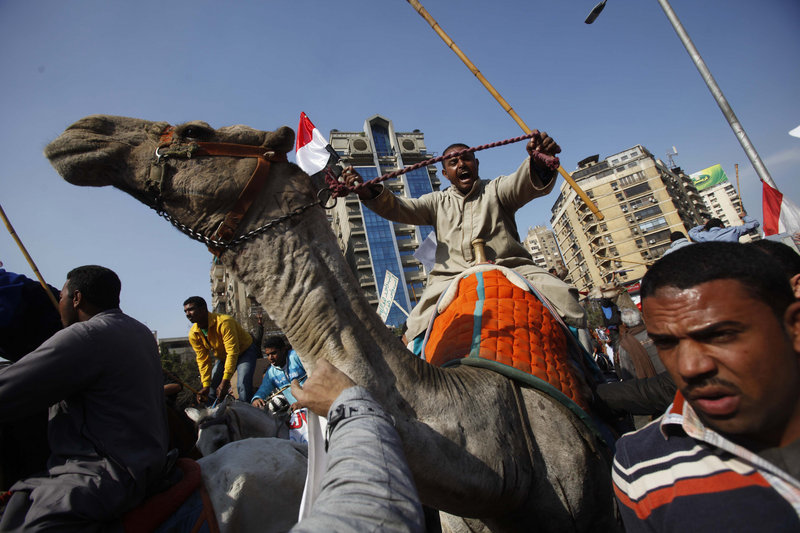CAIRO – Not long after Egyptian President Hosni Mubarak pledged political reforms and promised not to run for a sixth five-year term, pro-government demonstrators with reported connections to the Egyptian security forces laid siege to a downtown square Wednesday and fought fierce battles with anti-government protesters.
The assault was so well planned that it suggested government orchestration, or at least complicity, according to political observers, who noted that Mubarak backers had been conspicuously silent during a week of massive demonstrations against him.
The strategy of sending in the thugs after making half-hearted promises was vintage Mubarak. The tactic is familiar to political observers, for Mubarak has employed the same approach in national elections — assuring Western allies of fair polls and instead rounding up opposition candidates and dispatching foot soldiers to rough up their supporters.
Samer Shehata, an Egypt expert at Georgetown University, said Mubarak has used such tactics for years to break up anti-government demonstrations and to prevent opposition supporters from casting ballots.
During previous election violence, the United States issued only muted rebukes, because many of the targets were Islamists with hostile views of U.S. and Israeli policy. Faced with Egypt’s swelling grass-roots reform movement, however, the Obama administration has been forced to rethink its longtime alliance with Mubarak.
At least since the end of 2005, the regime has employed thugs and members of the security services dressed in civilian clothes against protesters and during election time, said Shehata, who spent months in Egypt studying the conduct of the 2005 parliamentary polls and the 2006 presidential contest. At a number of these protests, the regime operatives have had police-issued truncheons.
The timing of the mayhem also was significant, coming one day after the 82-year-old Mubarak, who has ruled for 30 years, pledged pro-democratic reforms such as setting presidential term limits and loosening restrictions listed in the constitution, which at present basically enshrines one-party rule. The provision he explicitly mentioned for reform, Article 76, lays out myriad obstacles to prevent opposition parties from running for office, which in turn guarantees the elections for Mubarak.
Opposition groups don’t have enough legislative power to pressure lawmakers from Mubarak’s ruling National Democratic Party to institute the reforms, and they are unlikely to have much impact on the process. Mubarak supporters made possible the constitutional amendment in the first place, and they hold a vast majority in the Egyptian parliament, from which any changes to Article 76 would come.
For years, Mubarak has assured his international detractors that he was reforming his regime, whose leaders and their business associates dominate political and economic life in Egypt. Those reforms never materialized, and Wednesday’s violence didn’t point to any such changes on the horizon. The bloodshed in Tahrir Square came not even 24 hours after President Obama gave a televised speech the same night, asking Mubarak to begin a peaceful transfer of power.
Mubarak is thumbing his nose at the United States and the Egyptian people, said Amr Shalakany, a professor at Cairo University and the American University in Cairo. “He’s saying, ‘You want me to leave? I will not leave. You will not intervene in my domestic affairs. And I will kill my people.”‘
Although Egyptians are used to Mubarak’s “baltageya,” local slang for thugs, the rampage they witnessed Wednesday went far beyond any previous clashes and was an ominous sign of more battles to come in the fight for control of the Arab world’s most populous nation.
In the melee, protesters and Mubarak supporters waged hand-to-hand combat involving guns, machetes, sticks, whips, rocks and concrete blocks. The military fired warning shots when the violence encroached on the National Museum, but the army did not intervene to stop the clashes.
Groups of Mubarak supporters even charged into the square on camel and horseback. The men were said to have been tourist touts who typically work at the Giza pyramids, and the presence of their animals downtown would have been impossible without at least tacit government consent.
“How do camels and horses in those numbers reach Tahrir Square?” asked Shalakany, the professor. “It looked like a Hollywood large-scale production from those big movies of the ’50s, like … ‘Cleopatra’ or something.”
Send questions/comments to the editors.



Success. Please wait for the page to reload. If the page does not reload within 5 seconds, please refresh the page.
Enter your email and password to access comments.
Hi, to comment on stories you must . This profile is in addition to your subscription and website login.
Already have a commenting profile? .
Invalid username/password.
Please check your email to confirm and complete your registration.
Only subscribers are eligible to post comments. Please subscribe or login first for digital access. Here’s why.
Use the form below to reset your password. When you've submitted your account email, we will send an email with a reset code.